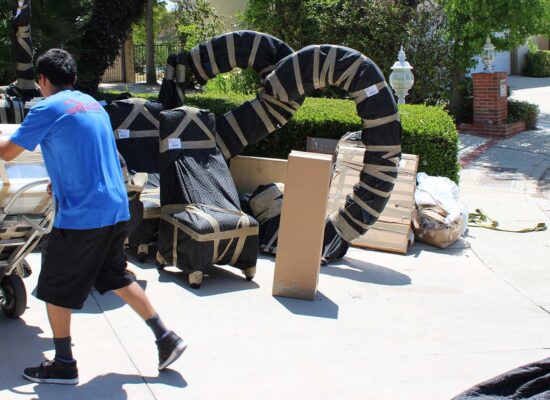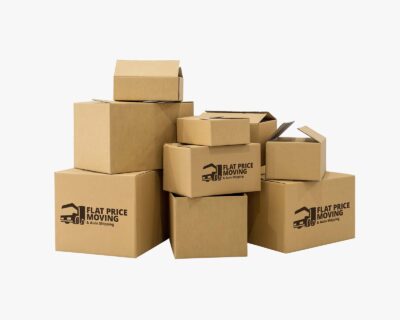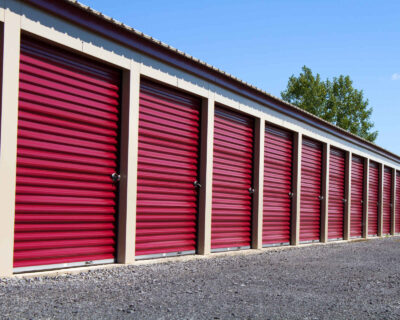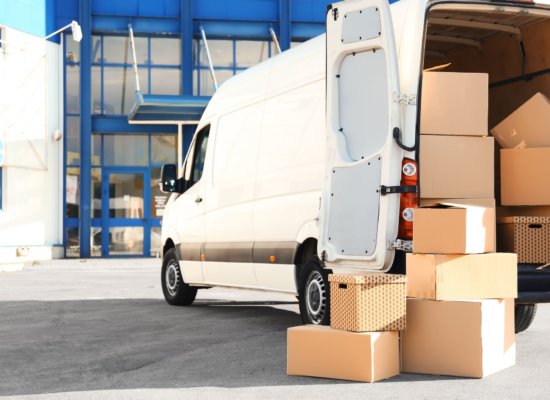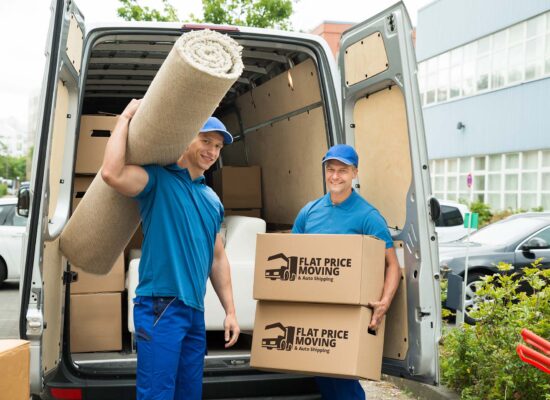Keep Your Grass Greener: 7 Tips for Moving a Lawn Mower
Discover these essential tips for safely and effectively moving a lawn mower. From fuel management and blade preparation to proper storage and safe transportation, we’ve got you covered. Let us help you with our expert advice on having a smooth relocation and keeping your grass greener after reaching your new destination.
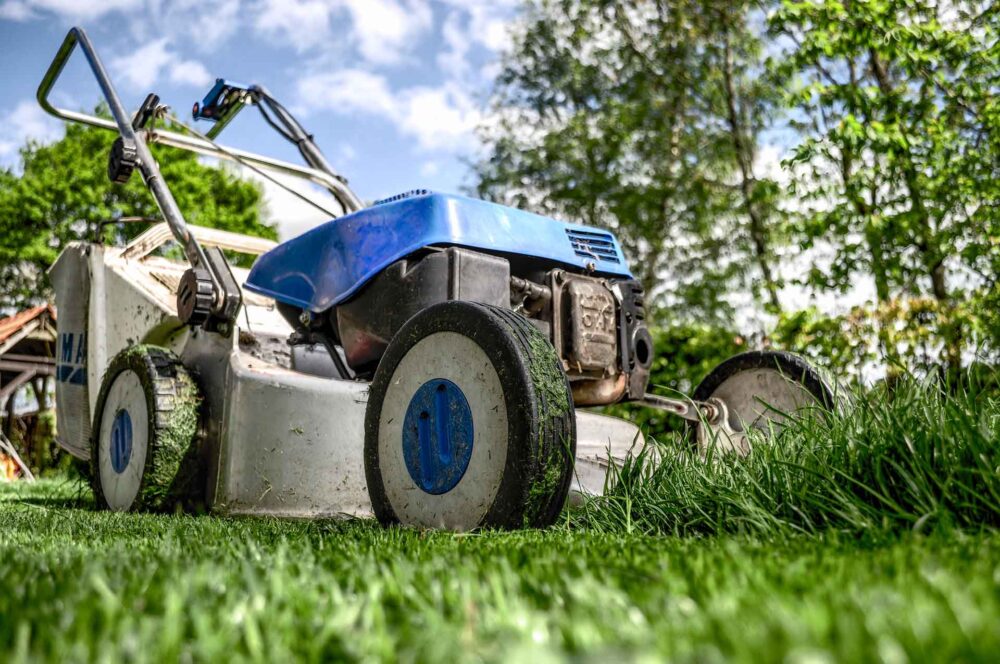
How to transport a lawn mower? Decide if your old grass cutter is worth the trouble or if you should buy a new one after relocation. If you opt for transporting it, clean it and its air filter, check the oil levels and replace the spark plugs. Drain the fuel and disconnect the battery before you box up your machine. Research the safe transportation options or hire movers to do it for you.
#1 Before Moving the Lawn Mower, Make Sure It Is Worth the Trouble
There are several factors you should look into before deciding whether to move your machine or not. First, assess the age, condition, and overall value of the object. If it’s old or in poor condition, replacing it at the destination might be more cost-effective.
Next, consider the expenses associated with migrating, such as transportation costs and potential repairs. Compare these costs with the price of purchasing a new one locally, and you will have a clear answer to this conundrum.
#2 Clean and Service the Lawn Mower
It goes without question that the machine needs to be cleaned before being transported across the country. By following these steps, you’ll ensure that your machine is clean, properly serviced, in good working condition, and ready for a safe and efficient move.
- Safety first – disconnect the spark plug wire to prevent accidental starting.
- Remove debris – thoroughly clean the exterior of the tool, removing grass clippings, dirt, and other debris.
- Check the undercarriage – clear any built-up grass or debris from the undercarriage to ensure proper airflow.
- Clean the air filter – either clean or replace the air filter according to the manufacturer’s instructions.
- Change the oil – if it’s time for an oil change, drain the old oil and replace it, as recommended by the manual.
- Inspect and sharpen the blades – check the blades for dullness or damage. Sharpen or replace them if necessary.
- Check the fuel – if you’re transporting a gas-powered machine, either run it until the tank is nearly empty or carefully drain the fuel.
- Perform any recommended maintenance – consult the owner’s manual for specific maintenance tasks such as lubricating moving parts or replacing spark plugs.
Remove Debris and Grass Clippings From the Mower Deck and Cutting Blades
You should start by turning it off and disconnecting the spark plug wire for safety. Then, using a brush or scraper, carefully remove any accumulated debris and clumps of grass from its deck. Pay close attention to the underside of the deck, as this area tends to accumulate the most grass and dirt.
Next, inspect the cutting blades and remove any clippings stuck between the blades. You can use a wire brush or a cloth to clean the blades thoroughly. Ensuring that everything is clean will not only help prevent damage during transportation but also improve the overall performance of your machine when you’re ready to use it again.
Check and Change the Oil, Clean the Air Filter, and Replace Spark Plugs if Necessary
Start by checking the oil level and condition. If the oil appears dirty or is below the recommended level, drain and replace it with fresh, high-quality oil as specified in the owner’s manual, and inspect the air filter for dirt, debris, or damage.
Clean or replace the air filter according to the manufacturer’s instructions to ensure proper airflow and optimal engine performance. Lastly, check the spark plugs for signs of wear or fouling. If they’re damaged or excessively worn, replace them with new ones to maintain efficient combustion.
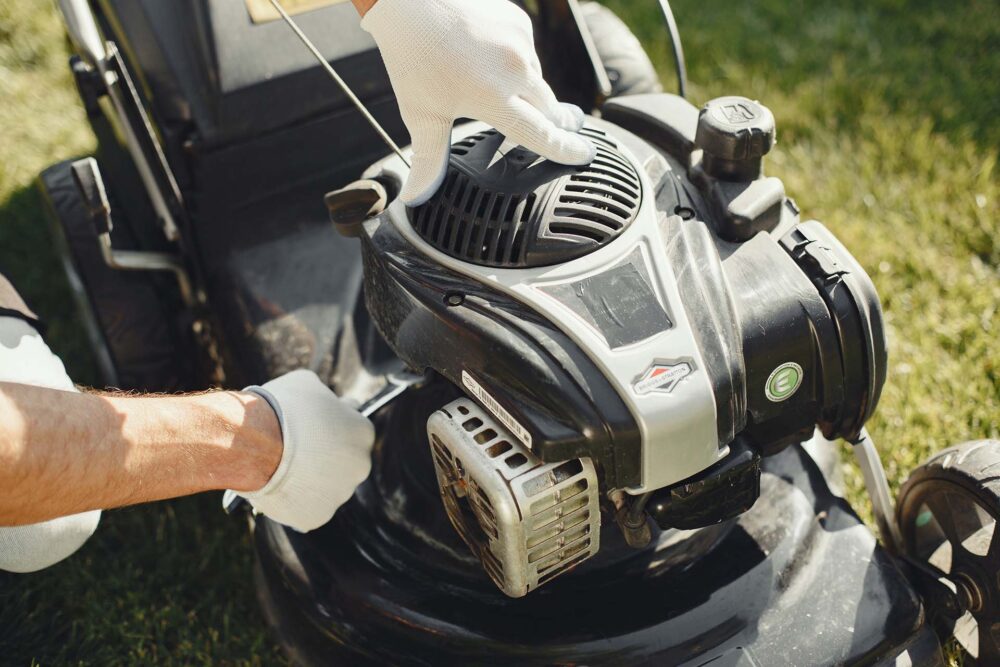
#3 Drain Fuel and Disconnect the Battery to Prevent Spillage
Fuel can leak during transportation, leading to potential hazards such as fire or environmental contamination. By draining the fuel tank, you minimize the risk of fuel leakage and avoid the mess and inconvenience it can cause.
Disconnecting the battery is important as well, as it prevents accidental starts and potential electrical issues during relocation. So be sure to drain your object properly, or your chosen movers might not move it.
Use a Fuel Stabilizer or Run the Mower Until the Fuel Tank Is Empty
Fuel stabilizers help prevent the fuel from deteriorating and causing issues with the engine, especially during long periods of storage or transportation. Adding a fuel stabilizer to the tank can help preserve the fuel and maintain its quality. Alternatively, running the machine until the fuel tank is empty reduces the risk of fuel spilling in the trailer and potentially setting everything on fire.
Check the video below if you want to learn how fuel stabilizer works.
#4 Package and Secure the Lawn Mower to Avoid Damage
By following these packaging and securing guidelines, you can significantly reduce the chances of damage to your tool during transportation and ensure its safe arrival at the new location.
- Remove detachable parts – if possible, such as the grass catcher bag, mulching attachments, or other accessories. Pack them separately to prevent damage.
- Fold and secure the handle – if your machine has a foldable handle, fold it down and secure it in place using the provided locking mechanisms or straps. This reduces the risk of the handle getting damaged or causing an obstruction.
- Protect the blades – cover the cutting blades with blade covers or use padding to prevent any accidental contact with other belongings. Ensure the covers or padding are securely attached.
- Use proper packaging materials – place your machine in a sturdy, appropriately sized box or use a specially designed transportation crate if available. Fill any empty spaces with packing materials such as foam peanuts or padding and bubble wrap or packing paper to prevent shifting and provide cushioning.
- Label the box – clearly label the box as “Lawn Mower” and include any necessary handling instructions or warnings. This ensures that anyone handling the box knows its contents and can exercise proper care.
Use a Sturdy Box or Crate That Fits the Mower
The box or crate should provide enough space to accommodate the dimensions of the object without excessive movement or shifting. Ensure that the storage is made of durable material, such as thick cardboard or wood, capable of withstanding the rigors of transportation.
If using a box, reinforce the corners and seams with strong packaging tape to enhance its structural integrity. For a crate, ensure it is securely fastened with screws or nails to keep it stable during transit. Properly fitting the tool into the creative storage prevents it from bouncing around and getting damaged in the back of a relocation truck.
Secure the Mower With Straps or Padding
The straps and padding serve two purposes. First, they prevent the object from shifting or moving around inside the packaging while reducing the risk of damage from impact or vibration. Second, they provide an extra layer of protection to safeguard it from scratches, dents, or other physical damage.
Use sturdy straps or ratchet tie-downs to secure the object inside the package. Place the straps over its top and tighten them securely, ensuring the item is held firmly in place. Check the tightness of the straps to prevent any movement during transit.
Keep in mind that padding materials such as foam, bubble wrap, or blankets will create a protective layer around your machine. Wrap the padding around it while paying attention to vulnerable areas like the engine, handles, and wheels. Secure the padding in place with tape or fasteners to prevent it from coming loose.
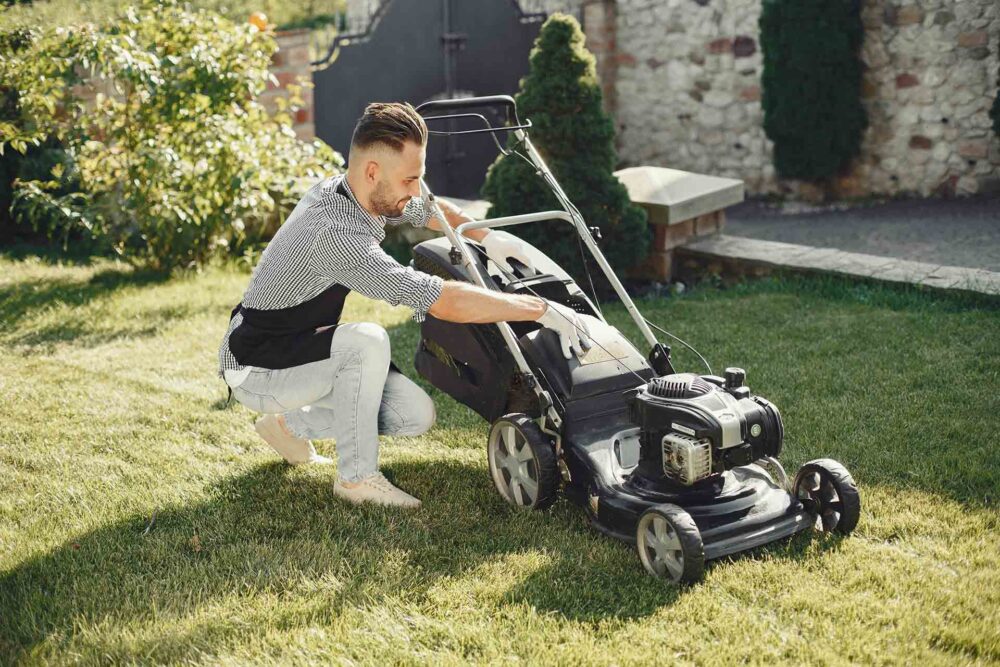
#5 Research Viable Transportation Options
Start by evaluating whether your relocation budget allows you to transport the machine yourself, considering factors like vehicle capacity and the physical effort involved. Next, check with local moving companies to see if they offer specialized services for transporting large items like grass cutters.
Compare costs, read reviews and testimonials, check whether the company is legitimate on the FMCSA website, and ensure that the auto transport company provides adequate insurance coverage. Confirm scheduling and logistics, making sure to communicate any specific requirements for one stress-free relocation.
#6 Hire Professional Cross-Country Movers
When it comes to moving your grass cutter across the country, hiring long-distance movers can be a smart choice. Flat Price Auto Transport and Moving specializes in handling all aspects of long-distance relocations, including the safe transportation of large and delicate items like your tools.
By booking our car shipping company, you can experience relocation benefits through our professional packing services, securing and shipping your belongings with utmost care. We have the necessary equipment, such as ramps, straps, and proper packaging materials, to ensure that even your grass cutter is protected throughout the journey.
Packing Services
Our moving teams are trained to pack your belongings in the most efficient manner possible.
Read moreMoving Services
Whether you are moving from New York to Los Angeles or from San Francisco to Chicago, we can help you.
Read moreStorage Service
Knowing what kind of surprises cross country move may hold, we offer 30 day free storage for belongings at the origin state.
Read more#7 Perform Maintenance and Care at the New Location
Upon reaching your new location, it’s important to perform proper maintenance and care for your item. Start by consulting the owner’s manual for any specific recommendations or adjustments that may be necessary due to the unique environmental conditions of your new area.
Develop a schedule for routine maintenance tasks like blade sharpening, oil changes, air filter replacement, regular cleaning, and spark plug inspection. This ensures optimal performance and extends the machine’s lifespan. Store it in a dry and secure location, such as a shed or garage, using a cover to protect it from dust and moisture. Address any repairs promptly to prevent further damage.

Follow Our Tips, and the Relocation Will Be Seamless
For a seamless relocation, we recommend following our expert tips and entrusting your move to our long-distance moving company. The Flat Price Auto Transport and Moving professional crew is experienced in handling delicate items like grass cutters. With our reliable and efficient long-distance moving services, you can have peace of mind knowing that your relocation will be handled with utmost care and attention to detail. Contact us today and allow us to make your move efficient, stress-free, and smooth.
FAQ
How to Transport a Riding Lawn Mower?
Ensure the machine is turned off and cool before loading it. Disable the engine by disconnecting the battery or removing the spark plug. Lower any attachments, such as the cutting deck or bagging system, to reduce its height and secure it onto a trailer or truck bed using straps or chains.
Can I Transport My Lawn Mower With Fuel in the Tank?
It is generally recommended to transport your machine with an empty or nearly empty fuel tank to avoid spills and safety hazards.
How Should I Prepare the Lawn Mower for Long-Distance Transportation?
Clean it, remove any debris, secure loose parts, and consider draining the fuel and oil. Consult your owner’s manual for specific instructions.
Can I Transport My Lawn Mower in an Upright Position?
It is generally best to transport it in a horizontal position to prevent potential oil leaks.
How Should I Prepare the Cutting Blades of the Lawn Mower for Transportation?
Ensure the blades are clean, sharp, and securely fastened. Consider using blade covers or padding for protection.
What Should I Do if My Lawn Mower Has a Bagging or Mulching Attachment?
Remove the bagging or mulching attachment before transportation, as it can get damaged or cause damage to other parts.
Is It Necessary to Remove the Wheels or Other Detachable Parts Before Moving the Lawn Mower?
It is not usually necessary to remove the wheels or other detachable parts unless specified in the owner’s manual or for easier transportation.
Can I Transport My Electric or Battery-Powered Lawn Mower in the Same Way as a Gas-Powered One?
Electric or battery-powered machines may have specific instructions in the owner’s manual, but in general, they can be transported similarly to gas-powered ones.
Are There Any Specific Regulations or Restrictions for Moving a Lawn Mower Across State Lines?
Regulations and restrictions can vary by state, so it’s advisable to check with relevant transportation authorities for any specific requirements.
Should I Notify the Moving Company About Any Hazardous Materials or Substances in the Lawn Mower?
Yes, it is important to inform the moving company if your machine contains hazardous materials or substances, as they may have specific guidelines for handling them.
How Soon After the Move Can I Start Using My Lawn Mower Again?
Once you’ve properly unpacked and inspected the machine, you can typically start using it again as soon as you are ready.
What Steps Should I Take To Ensure the Safe Storage of the Lawn Mower at the New Location?
Store it in a clean and dry area, consider using a cover to protect it from dust and moisture, and follow any additional storage instructions provided by the manufacturer.
Can I Hire a Professional to Service or Inspect My Lawn Mower After the Move?
Yes, you can hire a professional to service or inspect it after the move, especially if it requires maintenance or you have concerns about its condition.



